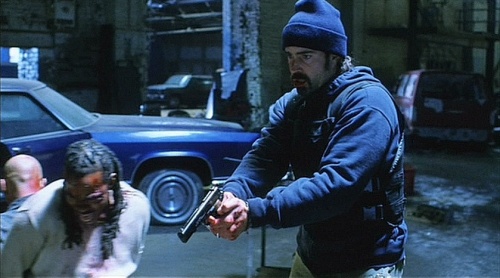When we speak about the “use of force,” I notice more and more that officers either need or want the green light to be given to them before they act. Correctional officers deep down have an intimate fear when it comes to the use of force of either reacting too soon, or too late resulting in injury of someone, or not at all. They have a natural ingrained fear of the criminals themselves, their administration not backing them for their actions or decisions as well as their peers not having their backs because of those very same reasons. They have terms thrown at them such as, “Reasonable,” “Excessive,” and “Liability,” with no clear cut explained definitions as well as no clear cut directions or leadership by the administrations. It is often said that it is easier to ask for forgiveness than to request permission, but in today’s litigious society this may be true, but painfully unforgiving on your career.
In this article I will attempt to give you those “green light indicators” as well as behavioral indicators that you may be assaulted or attacked. If all inmates had a green light indicator above their heads that when activated meant you could immediately utilize force we would all be better off and sleep better at night. I have gone through internal and criminal investigations relating to the use of force I have used and let me tell you, they are not fun. You lose sleep; you become irritable towards your family because of the internal stress and your mind plays tricks on you as it relates to the armchair quarterbacking of the incident conducted by the administration and your peers. You may even start to doubt yourself and question your reasoning for using force before it is all over with, at the least, your zest toward using force will diminish after your reasoning and motivation are questioned. You will start to hear officers say, “I am not touching anyone!”
In the court case Graham v. Conner the Court gave no definitive answer for law enforcement or corrections on what is reasonable as it pertains to excessive force. Consequently; it is possible for an officer to follow his training, departmental policy, and the standard operating procedure of the supervisory staff and still be wrong. In following all of the aforementioned steps the officer can still be charged criminally, sued civilly, and find that the judge and jury will find that his responses to the resistance still deemed inappropriate. This can prompt the responses to incidence of force by officer such as, “They are going to screw me anyway so I’ll make it worth my while.” Officers will make the use of force vengeful and vindictive. Officers may even choose to not get involved in the incidents or look the other way as it is occurring. Of course either course of actions is inappropriate.
No matter what you have done during your shift you can pretty much bet that your agency will not be disbanded for your actions or the actions of others. But you on the other hand are a dispensable entity, and your career may end because of your decisions. You may lose your credibility with your peers, your supervisors, and the administration. You may be disciplined and even terminated and that may not be the end but just the beginning of your issues. Depending on the incident you may be criminally charged, or at the least, civilly sued for that thirty second decision to place your hands on an individual. During this emotional and stressful time your marriage may fail only adding to your anxiety and turmoil. Sounds like fun, don’t it? Makes you wonder why we do what we do for a living doesn’t it.
The current Supreme Court legal decisions and judgments that have been made regarding the use of force state clearly that you are to be given a fair amount of latitude in your reasons to utilize force. Those allowances are to be made for the fact that the split second judgments that you make are in circumstances that are tense, uncertain and rapidly evolving. Armchair quarterbacking should not be utilized in the investigation phase as hindsight is 20/20 as well as the application of others judgments for consideration of criminal charges but yet we all know that you will definitely be judged by others from the onset of the force that you use.
With all of this on your shoulders your own personal safety and survival mentality must be always on your mind. I see video tapes of officers who were assaulted by inmates and those inmates, prior to the assault, clearly exhibited verbal and non-verbal signals of their aggressive intentions that were either missed or ignored by the officers. The prevalent attitude exhibited by those officers was that, “It will never happen to me.” This mentality is observed throughout the institution in some officer’s daily routines. I want to give you some verbal and non-verbal indicators that you can place into your use of force reports and use by observations throughout your daily activities which the inmates may exhibit prompting you to utilize force or request assistance before the need for force arises.
Inmates will rarely attack you without letting you know what they plan to do. Their aggressive statements are meant to prompt some sort of a fearful submissive response from you, hopefully fear and intimidation. Their ultimate goal is to have you fear them and hold you as their pawn to move and place across the board as they want. Possible inmate verbal and non-verbal behavior indicators to attack need to be constantly observed and documented in your reports as they will save your butt and prevent your surprise injury.
Assessing behavior and preventing a physical assault should be accomplished whenever possible. It is critical for an officer to recognize and assess aggressive verbal and physical actions of a person. Recognizing verbal and nonverbal aggressive behavior signals will aid the officer in preventing and de-escalating situations. Also, it prepares the officer mentally and physically to take immediate counter actions should a physical assault occur. Before physical action by an aggressor occurs, that individual usually begins to threaten to attack, in an attempt to intimidate the opponent, through a process sometimes called posturing, ritualized combat, or affective aggression.
The individual may tell you what they are about to do, “I’m going to kick your ass!” Or, they may exhibit:
- Visible overt awareness – visible weapons/unusual bulges/unusual nervousness/hands in view;
- Their face may show tension and will tighten or twitch, the jaws and lips will tense into a biting position as well as quiver and mouth expressions will frown and tighten over the teeth;
- Their body posture will display broadside with their hands on their hips or clasped behind their head. They subconsciously will take a bladed boxers stance and will rock back and forth or bob up and down on the balls of the feet. Stands taller, sets head and shoulders, moves away/moves closer, points, forms fist and/or loads the arm;
- Their hands will pump open and closed and then clench into a fist so much that their knuckles will go white. Always look at the hands and what they are doing with them;
- They will deepen their voice tones and the volume increases. The more threatened or aggressive an individual becomes the lower, harsher and louder their voice turns thus the bigger and tougher they seem. The deeper the voice the more authoritative they seem;
- The eyebrows will come down as if to shield the eyes. This makes them look more aggressive and intimidating;
- The nostrils will flare and their breathing will become rapid and deep. Lips separate to show teeth;
- Aggression redirected to something/someone else, such as breaking pencils, kicking, chairs, yelling at bystanders;
- The individual will seem to be looking through you; their eyes become glazed over with an empty stare. The individual will take on an uninterrupted stare with alternating eye stares and the eyelids will tighten down. They may attempt to get chest to chest with you;
- They may start sweating and beads of sweat will form on the forehead.
- Eye blinking; the blink rate reflects psychological arousal. The normal blink rate is about 20 closures per minute. Significantly faster rates may reflect emotional stress.
- Individuals will show exaggerated movements such as pacing, finger pointing, and threatening fists with bent arms. Their verbals will be relentless and rapid to get you to change your mind or change your last orders that have sent them over the edge. They want to win the confrontation.
- The individual may shed clothing such as taking off their shirts or jackets bend down and tighten their shoes or remove items of value such as watches and hats and set them aside.
- The individual will start to look around to assess witnesses, back-up available, escape routes or will start to target glance at the places they want to strike on your person.
- Vasodilatation and vasoconstriction or flushing of the face will also be evident at the tops of the ears by a darkening redness due to the release of adrenaline and noradrenalin into the bloodstream.
There is an inherent danger associated with the corrections profession. Whether an officer is in a county jail or a closed security segregation facility, wearing a uniform will put them in dangerous situations. Threat assessment is the act of becoming aware of a situation directly through the senses, including hearing and seeing, thereby making a reasonable determination about the risks involved. Any inmate potentially can be assaultive and use deadly force. However, approaching every inmate in a high-risk mode would be unreasonable. There can be many articulable facts that support threat assessment. Some of the facts used in this judgment decision are listed above; it is not a comprehensive complete listing.
How the Officer Should Respond to the aggression Nonverbally
Nonverbal indicators are probably the most important aspect of dealing with potentially aggressive inmates. When dealing with an agitated inmate, even more is conveyed nonverbally by the officer and less verbally.
1. Respect personal inmate space – Personal space is the area around a person in which he/she feels safe. For most inmates and situations, it is about 2 to 3 feet. Entering an upset inmate’s personal space intensifies their emotions. As a general rule, keep at least one arms length away, about 36 inches, to prevent escalation and to increase your own safety.
2. Maintain an open stance – Slightly turn your body at an angle to the other person. Keep your hands open and in plain view in front of your chest or at waist level. This stance is less threatening and offers a great advantage to stop an assault. Do not cross your arms or point your finger.
3. Eye contact and facial expression should be appropriate to the situation – Your face and eyes convey a direct message to the other person. Maintain general eye contact, but do not stare through the other person. Know inmate cultural habits. Some ethnic groups consider it inappropriate to directly look at another when upset or being disciplined. Your facial expression should be serious but not angry or fearful. You want to convey concern and control.
The bottom line is that you need to do your job, keep yourself and other staff members safe, while making good decisions that you will be able to defend legally. Use these examples of inmate’s threatening statements and behavior make the right decision and to justify your use of force response. Remember, it is often not enough to do the right thing – you must be able to explain in your reports and testimony why your actions were the right thing to do. Win the fight or force encounter and then win the war, court decision… Do not take the interaction personally because it may not be. Think of the interaction as a game, they are on a team where they will be attempting to circumvent your commands and resist your authority in every way. It is your job during this game to remain professional and apply just enough pressure to accomplish the task without introducing personal vendettas, abuse or attitude toward the individual.
Your response should be well documented and planned for your safety. You need not wait until you have been assaulted to gain control of the inmate. These indicators are presented subconsciously and if you watch and understand the arousal stress indicators you will be less likely to be assaulted out of nowhere. You will be prepared and ready for the assault before it happens.











